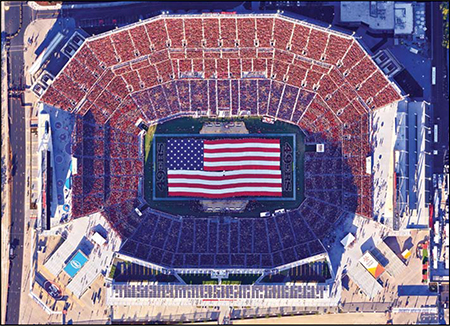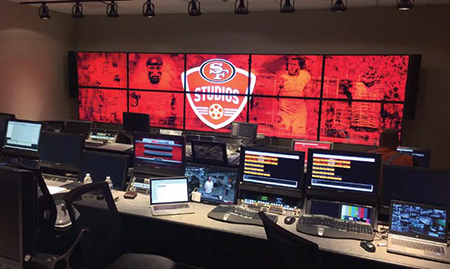Levi’s Stadium Highlights Fiber-Rich Tech
SANTA CLARA, CALIF.—Well sure, there’s an NFL game raging just a few hundred yards away. And, certainly, the 68,500 fans that are screaming in the background are a tad hard to ignore—that’s enough to get anyone’s heart pumping.

But what truly gets the attention of the stadium’s broadcast producer, who has been involved since 2012 when ground broke on the development of the new San Francisco 49ers stadium?
Why fiber, of course.
“When people ask me what I’m most excited about, I tell them it’s the fiber,” said Aron Kennedy, director of gameday productions and broadcast operations for Levi’s Stadium.
TECH FIRSTS
When the 49ers decided to leave its antiquated home of Candlestick Park in the foggy southeast shadow of San Francisco, they looked not only for warmer climes but for a location that would accommodate a 21st century stadium with all of the fan and technical amenities that were sorely lacking in the damp, dark and concrete confines of Candlestick Park.
The result is a $1.2 billion state-of-the-art technical behemoth in Santa Clara that proudly proclaims a number of firsts: first professional football stadium stamped with LEED Gold green certification, first stadium with a solar- and plant-covered roof, first stadium to combine a mix of reclaimed wood in its owner boxes and reclaimed water on its playing field.
The stadium is also aiming to be a first in a technical sense, too, by building a hardware and software infrastructure that allows fans to coordinate the experience of a stadium visit with the technological options that usually come from watching at home.
The professional video industry's #1 source for news, trends and product and tech information. Sign up below.
That’s where fiber comes in to play.

Designed by Diversified Systems, Levi’s Stadium has built a technical broadcast facility that includes two control rooms, one of which resembles a well-stocked production truck with a mix of clip players, servers and ecditing gear operated by a team of more than 40 technical operators. Designed by Diversified Systems Inc. a Dulles, Va.-based AV systems integrator, with system installation support from Sony, Levi’s Stadium has built in a technical broadcast facility that is so modern in its scope that older productions might have a hard time fitting in.
“There is so much fiber; so much so that it makes it difficult for an older [visiting production truck] to adapt,” Kennedy said. No triax, no copper. And like any proud technical papa, Kennedy can long expound on fiber’s ability to handle the twin challenges of distance and frequency throughout Levi’s Stadium.
Kennedy’s team has been tasked with producing a unique in-house broadcast that’s designed for the stadium’s vast network of in-house screens.
Two control rooms serve as command central. One is for the in-house broadcast team, including the PA announcer and sound control operator. The other is the nerve center of the production, a room that resembles a well-stocked production truck with a mix of clip players, servers and editing gear operated by a team of 43 technical operators.
Overseen by the TD and producer, technology in the production center includes ChyronHego CG graphics devices, Evertz DreamCatcher slow-motion replay devices, a Sony MVS-7000 production switcher and nearly a dozen Sony Bravia monitors. Signal processing gear includes Evertz multiviewers, Christie Spyder image processors and Elemental encoders.
Sony has installed a full complement of technology in the stadium, from large-scale LED displays to cameras, including 10 Sony F55 4K cameras outfitted with Fujinon and Canon lenses. The live show is produced in HD, but all images are being acquired in 4K for future Ultra HD productions and post upgrades.
“That’s why we’re using the F55s,” said Robert Alberino, Jr., vice president and executive producer for the San Francisco 49ers. “We want to be able to shoot for years and archive this footage and really extrapolate the best that 4K can offer. The entire show will be driven by this camera and it will allow us to have tremendous flexibility.”
The stadium also includes five POV cameras that are used to give basic views of the players leaving the locker rooms or to catch after-the-game press conferences.
IN-HOUSE PROGRAMMING
This complement of technology makes it possible for the production team to put together a complete broadcast-quality production, with the majority of the programing designated to the stadium’s network of screens, though feeds can be picked up by the national broadcast as well.
Those images will be most vibrantly seen on three vast Daktronix DVX Series LED boards, the largest of which is nearly 50-feet high and 200-feet long, as well as a ribbon display around the upper decks of the stadium. A Daktronics Show Control System will be used to integrate and control all displays.
A unique design on the south video board features an audio/video mesh display that includes Daktronix LED sticks that sit over the speaker system to allow sound to flow through.
“To hide the speakers, we used video sticks so that the sound can pass through, but it doesn’t affect the resolution of the screen,” Kennedy said.
A unique feature of the A/V system installation is the team’s ability to shoot game footage and deliver it live or via replay servers to mobile devices almost instantaneously. Nearly 2,000 screens are connected to the stadium’s proprietary A/V system, including menu boards, game broadcasts and statistics. The stadium is attempting to become a cashless, ticketless environment that will allow fans to order food or check the length of the restroom line without leaving their seat. Network infrastructure includes more than 400 miles of data cable, 70 miles of cable to support WiFi, more than 12,000 physical network ports and more than 1,200 free WiFi access points.
Earlier this year Comcast and NBCUniversal announced a 10-year agreement with the 49ers to provide fiber-based Ethernet Internet access and video capabilities across the stadium. The company’s regional arm, Comcast SportsNet Bay Area, has also built a 1,000-squarefoot TV studio for game day broadcasts.
The broadcast created by the in-house production team allows fans to watch the live feed, follow individual players, replay a touchdown from a camera angle that they choose, or watch the game from a unique perspective, such as focusing on the defensive line. Video feeds are being picked up via mobile devices through the Levi’s Stadium app.
The technology also extends beyond the field, with a companion 49ers Museum comprised of Sony 84-inch 4K LCD displays, touchscreen displays and professional 4K projectors.
All the technology, however, is simply there to support the mission of 49ers football, Kennedy said. The fact of the matter is, “if you’re winning, the fans love it,” and that’s what the in-house broadcast team is there to support: the fans’ immersion into the game day experience, he said.
Susan Ashworth is the former editor of TV Technology. In addition to her work covering the broadcast television industry, she has served as editor of two housing finance magazines and written about topics as varied as education, radio, chess, music and sports. Outside of her life as a writer, she recently served as president of a local nonprofit organization supporting girls in baseball.

